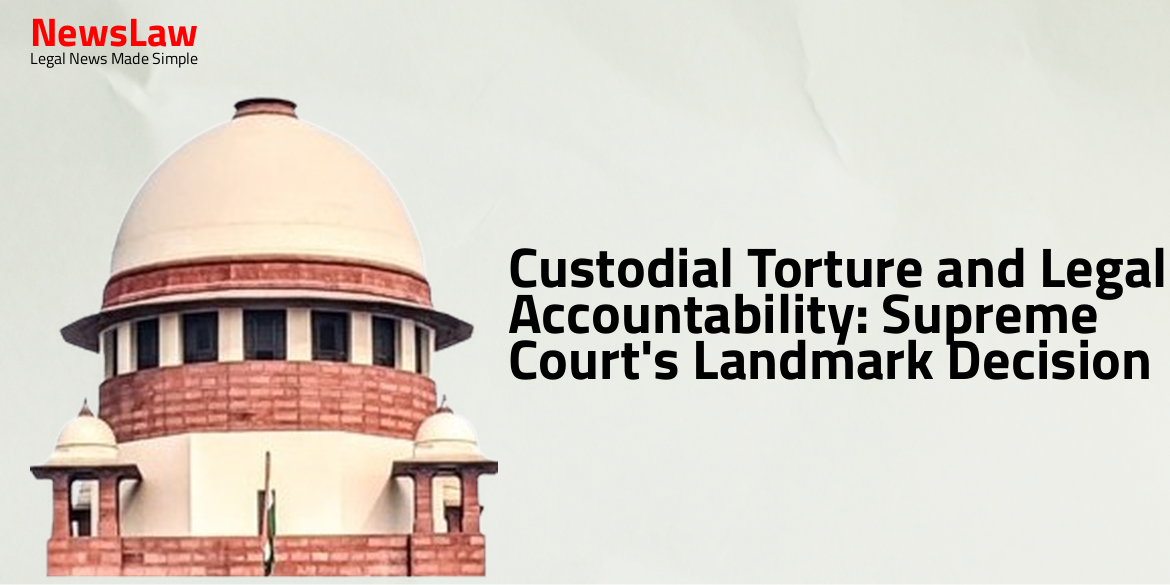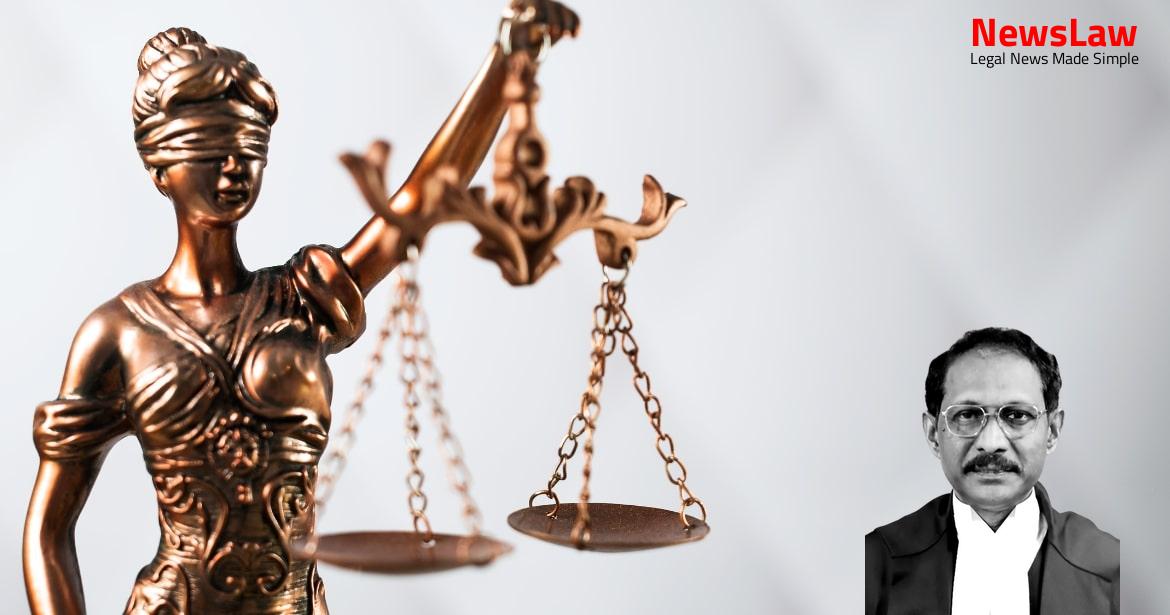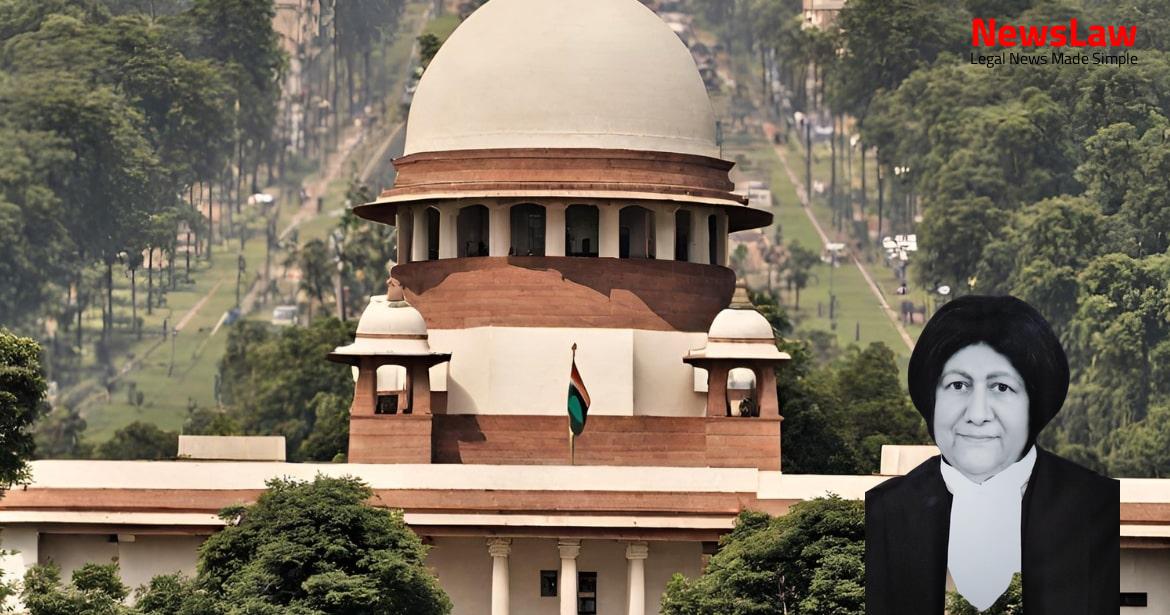The Supreme Court delivered a landmark decision on custodial torture and legal accountability, setting a precedent for justice in such cases. The case involved convictions and sentences of several individuals for offenses related to custodial death and torture. The judgment emphasized the burden of proof and the need for accountability in cases of police abuse, highlighting the importance of upholding Constitutional values. This significant ruling sheds light on the complexities of the legal system and implications for law enforcement practices.
Facts
- The appellant-convicts stood trial for offences under various sections of the IPC in connection with the death of Shama @ Kaliya.
- The Trial Court found the prosecution failed to establish the charge under Section 302, IPC, but succeeded in establishing charge under Section 304 -II read with Section 34 against accused numbers 1 to 3.
- The trial Court observed lack of direct evidence that all accused caused disappearance of the body of the deceased by setting it on fire.
- Accused Nos. 1, 2, and 4 were held guilty for causing the disappearance of the body by mutilation and convicted under Section 201 read with Section 34, IPC.
- The High Court acquitted all accused of the offences punishable under Section 201 read with Section 34, IPC, while confirming convictions for other offences except accused numbers 8 & 9.
- The State challenged acquittals of all accused for various offences while accused persons challenged their convictions.
- The appellant-convicts filed appeals against their convictions and sentences, except under Section 201 read with Section 34, IPC.
- The High Court confirmed the convictions and sentences except under Section 201 read with Section 34, IPC.
- A2 (Ravindra), A3 (Manohar), A4 (Hans Raj), A5 (Vishnu), A6 (Vishwanath) & A7 (Dilip) were convicted and sentenced for various offences under the IPC.
- All corporeal punishments of rigorous imprisonment were ordered to run concurrently for the appellant-convicts.
- Vijay Agrawal’s residence in Gondia was burglarized on 07.12.1995.
- Suspect Shama @ Kalya died on 22.12.1995 due to third-degree interrogation methods.
- An unidentified burnt and buried body was found in the forest in Balaghat district on 31.12.1995.
- Appellant-convicts made Dipak Lokhande run away to stage an escape of Shama @ Kalya.
- False evidence was fabricated by the appellants to avoid prosecution for custodial death.
- Convicts challenge their conviction under various IPC sections and the sentences imposed.
- Appellants’ acquittal under Section 201 read with Section 34, IPC is not being contested.
- Deceased Shama @ Kalya, a history sheeter, was taken into police custody regarding a house-breaking incident.
Also Read: Land Dispute: Decree Quashed by the Supreme Court of India
Arguments
- The learned senior counsel attempted to argue for a plain acquittal of all charges the appellants were found guilty of.
- Serious contentions were raised regarding the conviction for custodial death under Section 304-II read with Section 34 IPC and the subsequent sentence.
- The learned senior counsel asserted that there is no significant challenge against the appellants’ conviction for custodial torture.
Also Read: Supreme Court Judgment on Arbitral Award Dispute
Analysis
- The oral testimonies of witnesses confirmed the custody and torture of Shama at the Gondia Police Station.
- The evidence of Shalikram Nimkar, a police official, revealed falsification in the police records regarding Shama’s escape.
- The existence of the order dated 07.01.1996 from the Railway Court in Raipur was crucial in the case.
- The defense alleged a fabricated story of Shama’s escape to create an alibi.
- The prosecution failed to conclusively prove the identification of the deceased as Shama, casting doubt on the charges.
- The defense arguments and the evidentiary inconsistencies were not compelling enough to refute the prosecution’s claims of custodial torture and death.
- The High Court’s assessment and reversal of key findings from the Trial Court significantly impacted the overall judgment and charges against the accused.
- The acquittal of specific accused under Section 201 read with Section 34 had implications on additional charges in the case.
- The lack of concrete evidence regarding the dead body’s identification questioned the prosecution’s narrative of the events.
- The High Court’s emphasis on the burden of proof and the failure to corroborate crucial details weakened the prosecution’s case.
- In the case of Vishnu Dutt Sharma, the prosecution must prove the offense beyond a reasonable doubt.
- Excessive force by police is a result of a culture that justifies physical abuse as punishment.
- Lack of legal restraint on police powers leads to continuous abuse and violates Article 21 of the Constitution.
- The state has not taken adequate measures to control police abuse and implement reforms.
- The National Police Commission recommended a mandatory judicial inquiry by a District and Sessions Judge, which remains unimplemented.
- Organizational accountability is crucial in ensuring police respect Constitutional values and do not abuse power.
- In cases of custodial deaths, the burden of proof may need to be amended as suggested in the case of Ram Sagar Yadav.
- The court emphasized the importance of reliable evidence in establishing the offense of murder, even without the presence of the dead body.
- The Law Commission recommended reversing the burden of proof onto the police in cases of custodial death.
- Suspicion cannot substitute legal evidence, and conviction requires reliable and plausible evidence.
- The principle of ‘corpus delicti’ focuses on proving that a crime has been committed, not necessarily proving involvement.
- The burden of proof rests with the prosecution, and stricter proof is required for serious crimes.
- In some cases, the inability to find the dead body does not hinder the conviction if reliable evidence of the homicide is presented.
- Evidence of custodial torture shifts the burden to the police to prove their innocence in cases of deaths in custody or disappearances.
- Efforts by accused to destroy evidence tied to a murder must be proven beyond doubt, especially without the confirmation of the victim’s identity.
- The burden of proof differs for the accused and the prosecution.
- Wrong application of principle in appreciating evidence in criminal cases led to erroneous conclusions and findings in the judgment.
- Absence of medical and oral evidence to prove Shama @ Kalya sustained grievous hurt or specified kinds of hurt under Section 320 IPC.
- Rejection of the finding that Shama @ Kalya suffered injury cutting of veins of his legs.
- Lack of evidence regarding homicidal death of Shama @ Kalya in police custody, coupled with defense evidence and favorable circumstances for the accused.
- Accused in Criminal Appeal No.1617 entitled to acquittal for offense under Section 304 Part II read with Section 34 IPC due to benefit of doubt.
- Indian Police Act makes willful breach of regulations and unwarrantable personal violence punishable for policemen.
- Responsibility of police stations to ensure safe custody of prisoners as per Police Manuals.
- Disagreement with the conclusion that accused should be acquitted for lack of evidence regarding homicidal death, advocating for a more stringent punishment based on their actions.
- Impersonation by witness and manipulation of facts by appellants should not affect the verdict.
- Insistence on holding appellants accountable for their disregard for human life and the need for appropriate punishment.
Also Read: Judgment by the Supreme Court Of India: Upholding the Principles of Natural Justice
Decision
- Confirmation of the finding on custodial torture and conviction under Section 330, 348, and 387 read with Section 34, IPC.
- Conviction of appellant-convicts under Section 201, IPC read with Section 34, IPC except for causing the disappearance of evidence by destroying the dead body of Shama @ Kalya.
- Abatement of Crl. Appeal No.1614 of 2012.
- Partly allowed Crl. Appeal Nos.1615, 1616, 1617 & 1618 of 2012.
- Conviction of appellants in Crl. Appeal No.1617, 1618, and 1616 under Sections 330, 348, and 387, IPC, with one year of rigorous imprisonment and a fine of Rs.1,000/- each.
- Setting aside of conviction under Section 331 read with Section 34, IPC for accused Nos. 2, 3, 4, and 5.
- Setting aside of conviction based on finding guilt under Section 201, 202, 203, and 218 read with Section 34 for appellants-convicts.
- Maintenance of convictions and sentences as confirmed by the High Court.
- Dismissing all the appeals.
- Acquittal of all appellant-convicts of all other offenses for which they were convicted and sentenced.
Case Title: MANIK Vs. THE STATE OF MAHARASHTRA (2024 INSC 734)
Case Number: Crl.A. No.-001614-001618 – 2012



